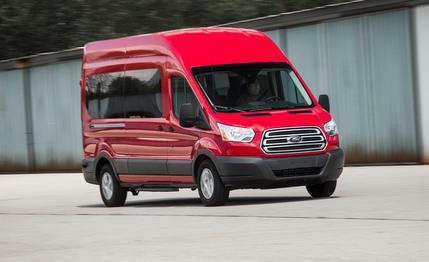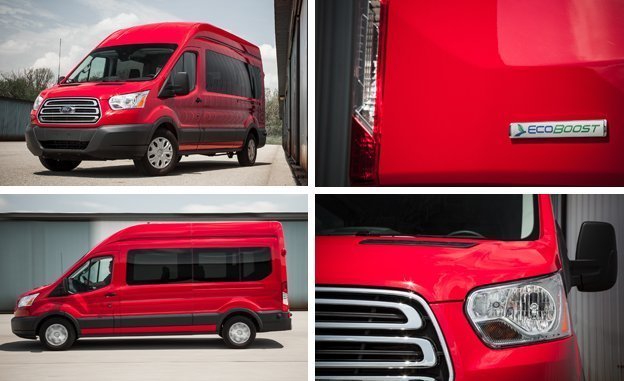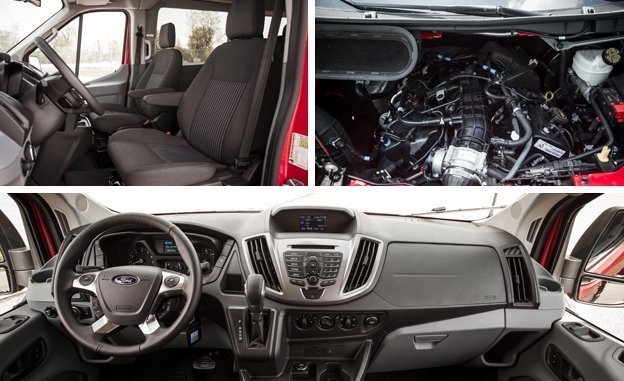 Instrumented Test
Instrumented Test
Before we give our full attention to the 2015 Ford Transit 350 XLT that is the subject of this test, let’s take a moment to give a shout-out to its predecessor, the legendary Ford E-series/Econoline. Debuting in the early 1960s, the first-generation Econoline employed a forward-control layout that positioned the driver and passenger above the front axle and placed the engine between them. But by the end of the decade, Ford figured it could make some significant gains in interior volume and packaging efficiency by moving the engine forward of the driver. Ford figured correctly, and Chevy and Dodge soon followed suit, both makers moving to a revised layout in 1971. In 1975, Ford punched the front bodywork out even farther for improved interior functionality. Dodge already had an extended-body 15-passenger van, and Ford eventually matched that with its own “Super Wagon” extended-body 15-passenger model. Over dozens of years, the Econoline remained largely unchanged, treated to only two significant makeovers: the first in 1992 to soften the corners of the bodywork, and the second in 2008 to square it back up and bring its cosmetics in line with those of Ford’s pickups.
As the E-series successfully rolled through the decades stateside, its overseas cousin, the Transit, was experiencing similar success on the Continent (for a backgrounder on the history of the Transit, go here). When it came time to finally replace the old Dearborn breadbox, it was decided through a confluence of factors, including the maker’s “One Ford” initiative, that its replacement would be designed with input from both Ford of Europe and North America. Enter the internationally known 2015 Ford Transit.

Ford offers the Transit in a multitude of configurations, including low, medium, or high roofs; a 130- or 148-inch wheelbase (the latter available with an extended body); single or dual rear wheels; seating for 8, 10, 12, or 15 passengers (or as a 2-seat cargo van); and your choice of a 3.2-liter turbocharged five-cylinder diesel, a naturally aspirated gasoline 3.7-liter V-6, or a twin-turbocharged 3.5-liter EcoBoost V-6. So you have options. Our test example was a Transit 350 Wagon XLT HR, which means a 148-inch wheelbase, single rear wheels, a high roof, a massive sliding door on the right-hand side, and windows running from stem to stern.
Thanks in part to all those windows, outward visibility is a revelation. Sure, this van’s archenemy, the Mercedes-Benz/Freightliner Sprinter, offers a similar glass area, but the windshield and front-door windows in the Transit dive deep, making maneuvers in tight quarters far easier than you’d expect for a nearly 20-foot-long vehicle. On the other hand, the S.S. Transit does require 43.7 feet to make a U-turn (39.2 feet for the regular-wheelbase version). Planning ahead is essential when it comes to navigating tight parking lots and driveways.
When you’re not cranking full lock, you notice that the Transit’s hydraulic rack-and-pinion steering speaks more in one day than the old E-series communicated in decades. Sure, it’s a bit overassisted, but it’s direct and linear. Teamed with a strut-type front suspension that also features an anti-roll bar, it manages to transcend the age-old “good enough for a van” dynamic paradigm and actually let a little enjoyment creep into the equation. Not as impressive but perfectly adequate is the 0.67 g the Transit recorded on the 300-foot skidpad. Push this 6451-pound shipping container on wheels to that limit, and you’ll find moderate understeer, the stability-control system kicking in to ensure a healthy relationship between the 16-inch wheels and the beads of the 235/65 Continental VancoFourSeason tires.

With confidence at the wheel established, we had no qualms exploring all 310 horsepower and 400 lb-ft of torque provided by the Transit’s 3.5-liter EcoBoost V-6 engine. This EcoBoost lives up to the latter part of its name, with peak torque available from 2250 rpm, and, honestly, it’s much faster than it needs to be. The zero-to-60 run consumed 7.5 seconds with just a driver onboard, while the Transit slipped through the quarter-mile in 15.9 seconds at 88 mph. That’s six-tenths quicker than the 16.5-second time we recorded in the significantly lighter, front-wheel-drive, V-6 2014 Ram ProMaster 1500 Cargo Van. If van drag-racing is your thing, the Transit deserves your consideration. (On a semi-related note, the Transit will do a burnout with traction control disabled.) Drivers have the option of calling their own gear swaps via a smallish button on the shifter, but unless you are traveling through mountainous regions, the automatic transmission does a pretty good job on its own.
Vans have never been known for their impressive stopping capabilities or spectacular fuel-economy numbers. While the Transit’s 202-foot stopping distance from 70 mph is about par for the segment (the aforementioned Ram ProMaster 1500 did the same in 199 feet, and the last Mercedes-Benz Sprinter we tested required only 194 feet), the stunning 22-mpg combined fuel-economy number we recorded in the Transit simply decimates the 14 mpg we logged with the ProMaster 1500. True, we did a lot of highway miles, but there was plenty of around-town driving mixed in.
Also in the Transit’s corner is value: A base Transit in passenger trim can be had for as little as $33,465, whereas the least expensive Sprinter passenger van currently carries a starting MSRP of $40,990. The base price for our high-roof XLT test vehicle was $42,025. After a trip through the options sheet—$1865 for the EcoBoost V-6; $325 for the limited-slip rear axle; $675 for privacy glass (essential given this van’s aquarium-like glass area); $75 engine-block heater; $295 for dual batteries; and a few other niceties—our Transit rang in at $46,730.
The world has changed since Ford boldly reimagined the van several decades ago, and never before has the market been as flush with alternatives. SUVs, crossovers, and even minivans—yeah, they still make those, and we just tested a bunch—are readily available, narrowing the niche occupied by the full-size van. But for those with transportation needs of epic proportions, there is still no substitute. And right now, the Transit is the van that knocks us out.